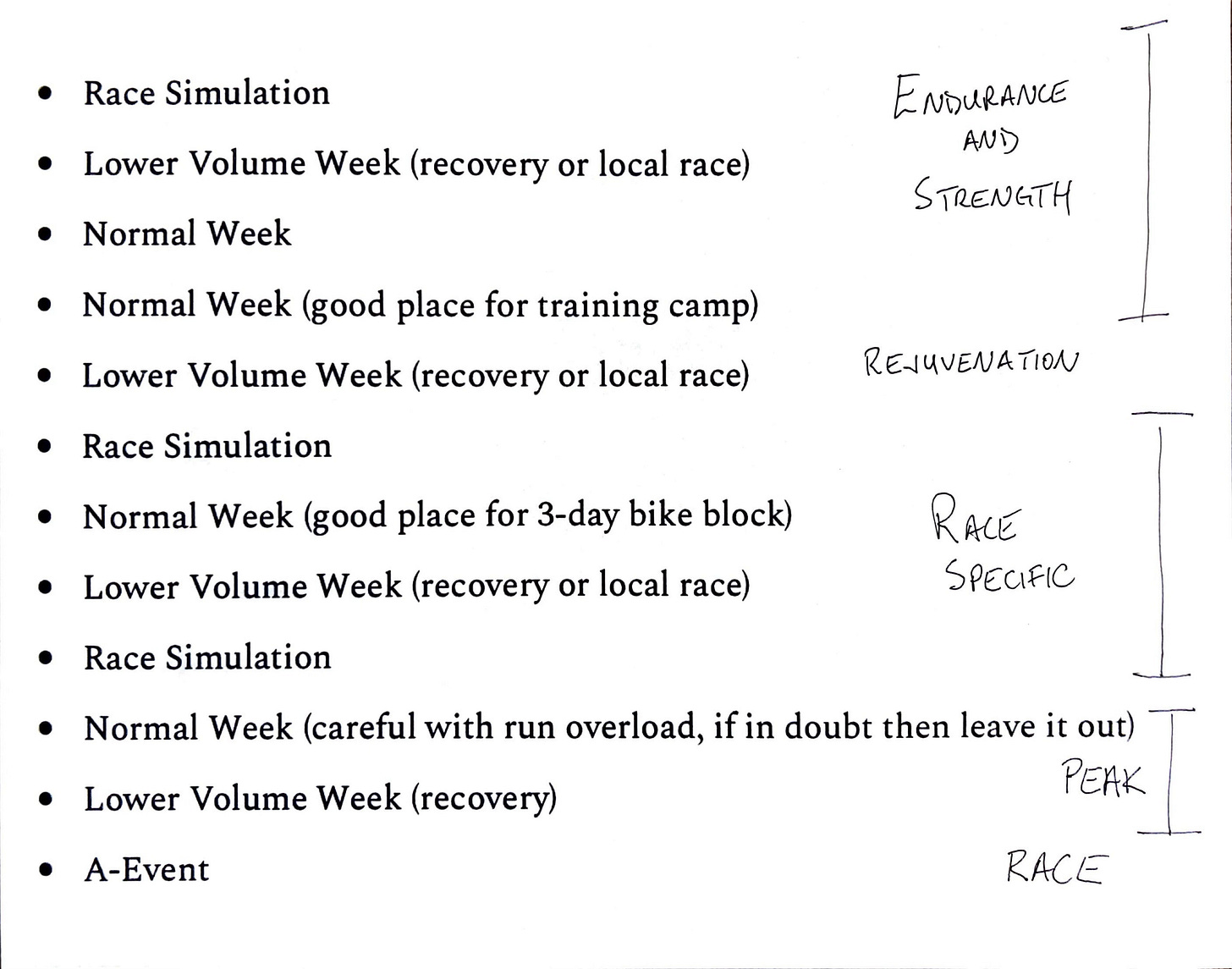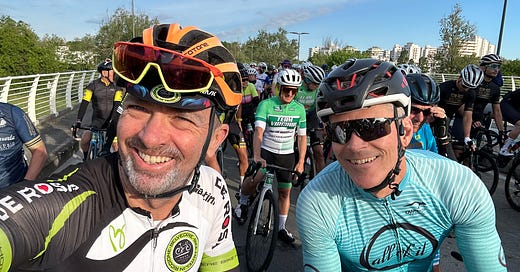
Let’s start with a recap.
Part One introduced block periodization:
Endurance and Strength - Build General Capacity
Race Specificity - Build Specific Capacity
VO2 Max - Increase The Size of Our Engines
Rejuvenation - Enable Long Term Upward Performance Progression
We then took at a deep dive into the VO2 Block as well as different types of athletes, and their needs.
Once we had done that, I laid out the first 4 to 6 months of your season:
One Month Off Season
Season Start Up
Six to Eight Weeks of Endurance & Strength Focus
Schedule A Maximal Test to confirm max heart rate and max lactate values.
VO2 Block
Coming Out Of A VO2 Block
The end of the VO2 Block is a great place to schedule a race and try out my Peak Like A Pro Protocol. By the time you’ve peaked, and recovered, you’ll find yourself in late-spring/early-summer.
You should be feeling good, training well and have seen material improvements with your fitness. If that is not the case then consider an additional two-week rejuvenation block where you:
Shed Chronic Fatigue
Focus On Low-Volume Exercise for Health
Consider The Causes Of Maladaptation
Setting The Duration of The Blocks
The next decision is the duration of your Strength & Endurance Block. This block will last anywhere from 2 to 9 weeks depending on factors you need to consider:
Calculate. Work backwards from your A-Event to see how many weeks are left.
Note. Race week and your peaking weeks, which will have a Race Specific focus.
Consider. How many Race Specific weeks work best for you. This is usually 2 to 6 weeks and will include: (a) rejuvenation weeks, and (b) low-priority races.1
If you are unsure then extend the Endurance and Strength Block.2

Defining Endurance
Endurance focus will vary by: (a) time of year, (b) athlete needs, and (c) the nature of the goal event.
Coming out of an offseason or extended break, the focus will be workout frequency. Build volume with frequent, rather than long, sessions.
Following the completion of a VO2 Block, frequency will be maintained with a greater emphasis on duration of the key loading days.
As fitness improves, all athletes are tempted to boost load, increase Green Zone targets and reduce the number of easy days. Let’s run through each of these.
Load. Training load is the result, not the goal of smart training. The goal of smart training is race performance.
Green Zone Targets. All athletes wonder if their easy training is too easy. If you’re unsure then test. Even if you test… look to your consistency and the fatigue being generated to decide if you are coping well. Our endurance days should be a source of joy and a break from the structured sets of our key workouts.
Easy Days. Rejuvenation is an essential component of longterm positive adaptation. As fitness rises, make the loading days more specific and keep the easy days easy. This is tough to do. You will be tempted to self-sabotage.
With both endurance and strength, be thinking about the components which will be required for your key race simulation workouts.
Prior training prepares the pieces required inside our race simulation workouts.
Our race simulation workouts are intended to prepare us to race.
Whether it’s a marathon, a sprint triathlon or an Ironman. We are building towards the specific requirements of the race simulation sessions.
Final tip => Volume Works. Short-duration bike-focused training camps (2-3 days long) are highly effective. Long-duration training is valuable tool to build endurance performance.
Defining Strength
Strength means hills. It can also mean:
Big Gear Work.
Sport-Specific Resistance Training.
Fly, Medley and Banded Swimming.
Bounding, Jumping and Plyometrics.
For the block that precedes the Race Specificity Block, consider the specific needs of your event.
Are there hills? Where are they in the race profile? How steep and how long?
Could the swim be choppy?
How is my durability? Am I fading at the end of my long sessions? How do my longest days compare to my race event?
Does event success require tolerance of extreme and rapid changes in pace?
The course, and the likely tactics of other athletes on the course, will impact which components of strength we need to train.
Specific tips based on my experience:
Runners. Balance hills with flat endurance workout. Even if your goal event is all hills, or all flat, a mix of terrains will serve you best.
Cyclists. Vary cadences when riding hills. Build a wide range of comfortable cadences. Notice your preferred cadence, then do some training against that preference.
Flat TT Power. Low cadence sets, where heart rate builds into Zone 3, are effective for building straight ahead power. If you struggle to generate speed on the flats, make these sets a key part of your weekly program. See our bike chapter, specifically this section.
Swimmers. Choppy open water swims are exhausting for pool swimmers. Medley swimming, fly sets and the use of bands greatly reduces the fatigue associated with challenging conditions. See our swim chapter for sets and ideas to help you prepare.
Everyone. Have fun. These sets should be moderately-hard (Zone 3) and not leave us trashed. There should be no disruption to the rest of the training week.
More ideas for you inside this video I published over the weekend.
Back to The Physics of Performance
Back to Table of Contents
In the terminology of Joe Friel’s Triathlete’s Training Bible…
When we are unsure between Base and Build… always choose Base.





The video includes the best description of strength and endurance I've come across.
Thanks
Training for my first IM. How far apart do you suggest separating each of the 100/130/150 trainings, and how far out from IM?